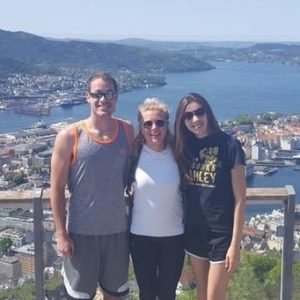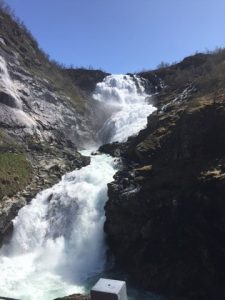Traveling Into History

Garret and I with our wonderful host in Berlin, Jenia
Guest blogger Laura Schott is a recent college graduate who took her first-ever trip to Europe to visit her ancestral lands of Germany and Norway.
In the midwestern United States, one can expect to find people of two origins: German and Scandinavian. My fiancé and I, both from Fargo, North Dakota, and both recent University of Minnesota graduates, are no exception. Thanks to my dad’s 100 percent heritage, German dominates my own ancestry, but my mom’s side added some dynamism into the mix: I am roughly 75 percent German, 25 percent Norwegian, and a wee bit of Irish and French. My fiancé, Garret, basically has the same heritage, minus the French—here’s to hoping we’re not related!
College graduates head for the countries of their ancestors
As a graduation gift, Garret and I treated ourselves to our first European vacation where we would visit our “homelands” of Norway and Germany. Two of our very close friends accompanied us to Norway, which we visited first, and continued their journey north as Garret and I took off in the southwest direction for Part II of our adventure in Germany.
The four of us first flew from Minneapolis to Boston to Iceland to Oslo, where we stayed with Camilla, a former exchange student that one of our friends hosted during her senior year of high school. Camilla and her family proved to be excellent hosts. After waking up at 3 a.m. in Minneapolis, then taking three successive plane rides, we arrived at their home in Asker (just north of Oslo) to an incredible smorgasbord of breakfast foods.
Different cultures, different foods

Garret and I with our Norwegian host, Camilla
If the beautiful scenery on the train ride to Asker hadn’t already told me we weren’t in the U.S. anymore, the food certainly did. Before Hege, Camilla’s mother, served us coffee, she warned that it would be quite a bit stronger than we were used to. When she visited her daughter in Minnesota a few years ago, she said that she’d been continually surprised (and disappointed) to find that American coffee tasted like water to her. I braced myself before taking the first gulp, and, while it was indeed strong, I proudly finished my mugful.
I didn’t ask for a refill, though.
Throughout the meal, it became apparent that Europeans are much more conscious of the freshness and authenticity of their foods than we are in America. We drank smoothies that were made entirely of fruit (no added sugar), a variety of goat cheese and cold cuts, and bread that was simply amazing.
I’m not sure quite how to describe it, but I think that Jenia, who would later be our host in Berlin, summed up the difference between American and European bread quite accurately: “Sorry, guys, I can’t do American bread,” she said, shaking her head and scrunching up her nose. “It just tastes artificial to me.” We assured her that there was no reason to be sorry—we agreed wholeheartedly and were not looking forward to returning to American bread ourselves!

Garret and I goofed off a bit at Vigeland Park
Vikings and Vigeland
After we slept off our jet lag, we were able to start exploring Norway. We began by spending a day in Oslo, where we visited a Viking museum that reminded me of the Hjemkomst Center in Moorhead, Minnesota. The highlight of the Hjemkomst Center is an exhibit devoted to Robert Asp, a former guidance counselor at Moorhead Junior High School.
Like many Minnesotans, Asp was proud of his Norwegian heritage, but he took his pride to the next level. Asp’s dream was to build a replica of an ancient Viking ship and sail it—all the way to Norway. Asp began plotting his endeavor in the summer of 1971.
Unfortunately, he passed away before his ship could set sail, but his Norwegian spirit, work ethic, and determination lived on in his children and friends who’d helped get the project underway. These friends and family members sailed the ship all the way to Norway in Asp’s honor. The crew of 12 was greeted by their families and honored by a hero’s welcome by the people of Bergen, Norway, on July 19, 1982. As a Midwesterner who was well acquainted with Asp’s story from many school field trips to the Hjemkomst Center, I felt an immediate connection with the Viking Ship museum, and later when we visited Bergen, the Hjemkomst’s landing site.
Camilla took us to some of Oslo’s best-known sites. We took a stroll through Vigeland Park, which is the most enigmatic sculpture park I’ve ever seen. It consists entirely of naked people cast in bronze, granite, and cast iron. These 200-some figures, all crafted by the sculptor Gustav Vigeland (1869–1943) attract a whopping one million visitors every year.
I don’t know what motivated Vigeland’s vision, and nor, to my knowledge, does any historical society in Oslo. There were no informational signs explaining the motive behind Vigeland’s crowning work.
 Experiencing places in a new way
Experiencing places in a new wayThis lack of signage was a difference we continued to notice throughout our trip. In America, it seems that if something has even the slightest claim to historical significance, it is accompanied by a sign giving eager viewers the background of what that thing is made of, the geographical region from which said material comes, the person who created/led/died in it, and the names of every person who may have influenced said person. And, of course, the thing at hand has its own snapchat filter and at least a handful of hashtags associated with it. None of this buzz seemed to exist in Norway; a site exists to be experienced in the moment rather than tweeted about.
We also came across this lack of informational signage and brochures during our Norway in a Nutshell tour, which I could not recommend more. It took us through the very different parts of Norwegian countryside—high, low, cold, hot, wet, dry, but ALL beautiful. As someone who loves to learn about the history of place, I was at first disappointed that Norway’s tourism had less to offer than America’s bombardment of information. However, as I stood between mountain peaks and felt the cool, wet air of an ancient waterfall rush past me, I realized that, sometimes, the best way to fully know a place is without the written word—a tough conclusion for me to come to.
But, one can always write about the experience of place later. 



